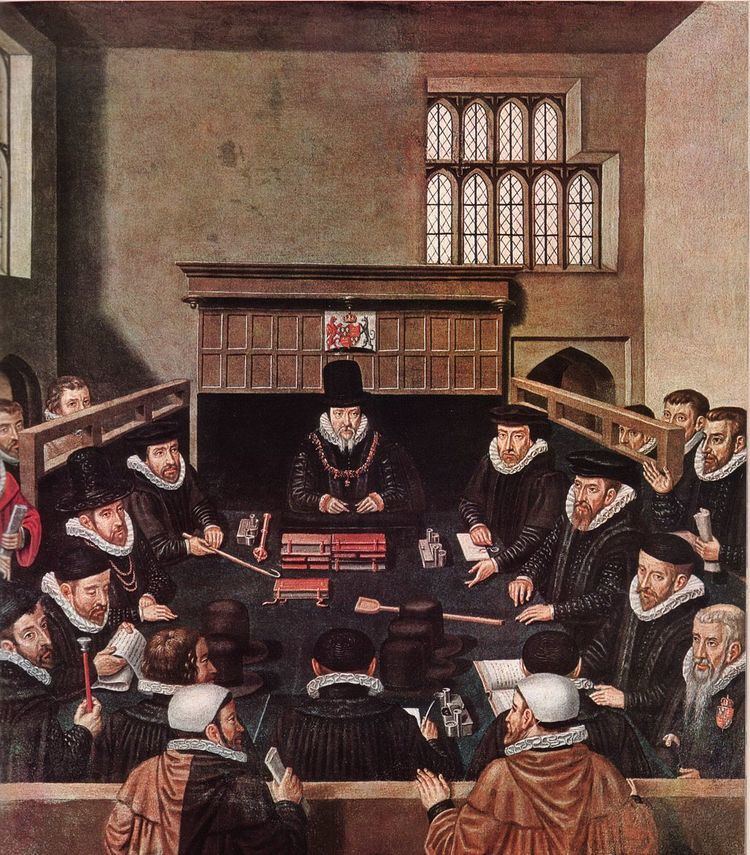 | ||
The Court of Wards and Liveries was a court established during the reign of Henry VIII in England. Its purpose was to administer a system of feudal dues; but as well as the revenue collection, the court was also responsible for wardship and livery issues.
Contents
- History
- Identification of wardships
- Increased exploitation of wardships by Tudors
- List of Masters of Wards
- Establishment of Court of Wards
- Amalgamation with Office of Liveries
- List of Surveyors of Liveries
- List of officers of Court of Ward and Liveries
- Master
- Receiver General
- References
The court was established from 1540 by two Acts of Parliament, Court of Wards Act 1540 (32 Henry VIII c. 46) and the Wards and Liveries Act 1541 (33 Henry VIII c. 22).
As Master of the Court, from 1561, William Cecil was responsible for the upbringing of orphaned heirs to peerages and also, until they came of age, for the administration of their estates.
In 1610, King James I attempted to negotiate with Parliament a regular income of £200,000 a year in return for the abolition of the hated Court of Wards. While the negotiations failed, the episode showed Parliament that the royal prerogative could be up for sale.
In February 1646 (New Style), during the English Civil War, the Court of Wards and Liveries lost its principal function, due to the abolition by the Long Parliament of feudal tenure. The court was formally abolished soon after the Restoration of the monarchy by the Tenures Abolition Act 1660 (12 Charles II c. 24).
History
Wardship of minor heirs of a tenant in chief was one of the king's ancient "feudal incidents" (amongst escheat, marriage, relief, custody of an "idiot", etc.), that is to say a right of royal prerogative dating back to the feudal principle of seigneurial guardianship. Such right entitled the king to all the revenues of the deceased's estate, excluding those lands, generally 1/3 of the estate, allocated to his widow as dower, until the heir reached his majority of 21, or 14 if a female. The king generally sold such wardships to the highest bidder or granted them gratis, generally by letters patent to a favoured courtier as a reward for services, which saved cash having to be found from the privy purse. On attainment of his majority at the age of 21, a proof of age inquisition would be held, resulting in a certification witnessed by prominent men from his local area who certified that he had reached the age of 21. Such certificate then formed the basis for the king to issue a writ to the custodian of the land in question to release it to the heir, who then obtained seizin.
An example of such grant made on 20 November 1495 is as follows:
Grant to William Martyn, esquire, and William Twynyho, esquire, of the keeping of the lands late of John Trenchard, tenant in chief, and after the death of Margaret, widow of the said John, of the lands which she holds in dower; with the wardship and marriage of Thomas Trenchard, his son and heir.
Identification of wardships
On the death of every tenant-in-chief the escheator of the county in which he held land was required to hold an inquisition post mortem and report to the Court of Chancery which identified the size and location of the holdings, the rents and services due under feudal land tenure, the name and age of the deceased and the name and age of his heir. A copy was sent to the Exchequer, and after 1540 to the Court of Wards and Liveries.
Increased exploitation of wardships by Tudors
The systems for the exploitation of royal feudal incidents fell into decay by the 15th century, but following the accession of King Henry VII (1485–1509) in 1485, and in order to replenish the royal treasury, a new importance was placed on fully exploiting such rights. Surveyors, commissioners and from 1514 county feodaries were appointed to actively search for and spy out potential royal wardships, and in each county there were established over wards retained by the king a master, receiver-general, auditor and particular receiver. Liberal rewards were paid to anyone providing information allowing the discovery of a new crown ward. Over all was appointed a "Master of the King's Wards", to be held at the king's pleasure, first established in late 1503, to supervise royal wardships and administer the lands and revenues of wards during the period of crown control, and to sell those not to be retained. The revenues were paid to the Treasurer of the Chamber, that is to say the king's private funds, not into the Treasury. The master originally was required to declare his accounts orally to the king's own person four times a year, which in 1531 was altered to require the rendering of such accounts to general surveyors.
List of Masters of Wards
(Source: Richardson, 1952, p. 487)
Establishment of Court of Wards
In 1540 the office of "Master of the King's Wards" was replaced by the Court of Wards, which assumed complete control of wards and the administration of their lands. This was inspired by the successful establishment of the Court of Augmentations in 1536, and it followed a similar organisation. The court had a seal and met in quarterly sessions. The other officials included a surveyor, attorney, receiver-general and two auditors.
Amalgamation with Office of Liveries
The office of "Surveyor of the King's Liveries" was in existence between 1514 and 1542, when the office was joined to the Court of Wards, becoming the "King's Court of Wards and Liveries".
List of Surveyors of Liveries
(Source: Richardson, 1952, p. 487)
List of officers of Court of Ward and Liveries
(Source: Richardson, 1952, p. 488)
